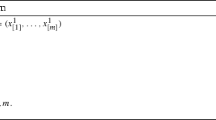Abstract
ELSO is an environment for the solution oflarge-scale optimization problems. With ELSO the user is required to provide only code for the evaluation of a partially separable function. ELSO exploits the partialseparability structure of the function to computethe gradient efficiently using automatic differentiation.We demonstrate ELSO's efficiency by comparing thevarious options available in ELSO.Our conclusion is that the hybrid option in ELSOprovides performance comparable to the hand-coded option, while having the significantadvantage of not requiring a hand-coded gradient orthe sparsity pattern of the partially separable function.In our test problems, which have carefully coded gradients,the computing time for the hybrid AD option is within a factor of two of thehand-coded option.
Similar content being viewed by others
References
B. M. Averick, R. G. Carter, J. J. Moré, and G-L. Xue. The MINPACK-2 test problem collection. Preprint MCS-P153-0692, Mathematics and Computer Science Division, Argonne National Laboratory, 1992.
B. M. Averick and J. J. Moré. Evaluation of large-scale optimization problems on vector and parallel architectures. SIAM J. Optimization, 4:708–721, 1994.
Christian Bischof, Ali Bouaricha, Peyvand Kahdemi, and Jorge J. Moré. Computing gradients in large-scale optimization using automatic differentiation. Preprint MCS-P488-0195, Argonne National Laboratory, Argonne, Illinois, 1995.
Christian Bischof, Alan Carle, George Corliss, Andreas Griewank, and Paul Hovland. ADIFOR: Generating derivative codes from Fortran programs. Scientific Programming, 1(1):1–29, 1992.
Christian Bischof, Alan Carle, and Peyvand Khademi. Fortran 77 interface specification to the SparsLinC library. Technical Report ANL/MCS-TM-196, Argonne National Laboratory, Argonne, Illinois, 1994.
Christian Bischof, Alan Carle, Peyvand Khademi, and Andrew Mauer. The ADIFOR 2.0 system for the automatic differentiation of Fortran 77 programs. Preprint MCS-P381-1194, Argonne National Laboratory, Argonne, Illinois, 1994. Also available as CRPC-TR94491, Center for Research on Parallel Computation, Rice University.
T. F. Coleman, B. S. Garbow, and J. J. Moré. Fortran subroutines for estimating sparse Jacobian matrices. ACM Trans. Math. Software, 10:346–347, 1984.
T. F. Coleman, B. S. Garbow, and J. J. Moré. Software for estimating sparse Jacobian matrices. ACM Trans. Math. Software, 10:329–345, 1984.
T. F. Coleman and J. J. Moré. Estimation of sparse Jacobian matrices and graph coloring problems. SIAM J. Numer. Anal., 20:187–209, 1983.
A. R. Conn, N. I. M. Gould, and Ph. L. Toint. LANCELOT. Springer Series in Computational Mathematics. Springer-Verlag, 1992.
A. Griewank and Ph. L. Toint. Numerical experiments with partially separable optimization problems. In D. F. Griffiths, editor, Numerical Analysis: Proceedings Dundee 1983, Lecture Notes in Mathematics 1066. Springer-Verlag, 1984.
Andreas Griewank. Achieving logarithmic growth of temporal and spatial complexity in reverse communication. Optim. Methods Software, 1:35–54, 1992.
Andreas Griewank. Some bounds on the complexity of gradients, Jacobians, and Hessians. In P.M. Pardalos, editor, Complexity in Nonlinear Optimization, pages 128–161. World Scientific Publishers, 1993.
Andreas Griewank and George F. Corliss, editors. Automatic Differentiation of Algorithms: Theory, Implementation, and Application. Society for industrial and Applied Mathematics, 1991.
M. Iri. History of automatic differentiation and rounding error estimation. In A. Griewank and G. F. Corliss, editors, Automatic Differentiation of Algorithms, pages 3–16. SIAM, 1992.
David Juedes. A taxonomy of automatic differentiation tools. In Andreas Griewank and George Corliss, editors, Automatic Differentiation of Algorithms: Theory, Implementation, and Application, pages 315–329. SIAM, 1991.
M. Lescrenier. Partially separable optimization and parallel computing. Ann. Oper. Res., 14:213–224, 1988.
D. C. Liu and J. Nocedal. On the limited memory BFGS method for large scale optimization. Math. Programming, 45:503–528, 1989.
Ph. L. Toint. Numerical solution of large sets of algebraic nonlinear equations. Math. Comp., 46:175–189, 1986.
Ph. L. Toint. On large scale nonlinear least squares calculations. SIAM J. Sci. Statist. Comput., 8:416–435, 1987.
Ph. L. Toint and D. Tuyttens. On large-scale nonlinear network optimization. Math. Programming, 48:125–159, 1990.
Ph. L. Toint and D. Tuyttens. LSNNO: A Fortran subroutine for solving large-scale nonlinear network optimization problems. ACM Trans. Math. Software, 18:308–328, 1992.
Author information
Authors and Affiliations
Rights and permissions
About this article
Cite this article
Bouaricha, A., Morè, J.J. Impact of Partial Separability on Large-Scale Optimization. Computational Optimization and Applications 7, 27–40 (1997). https://doi.org/10.1023/A:1008628114432
Issue Date:
DOI: https://doi.org/10.1023/A:1008628114432




